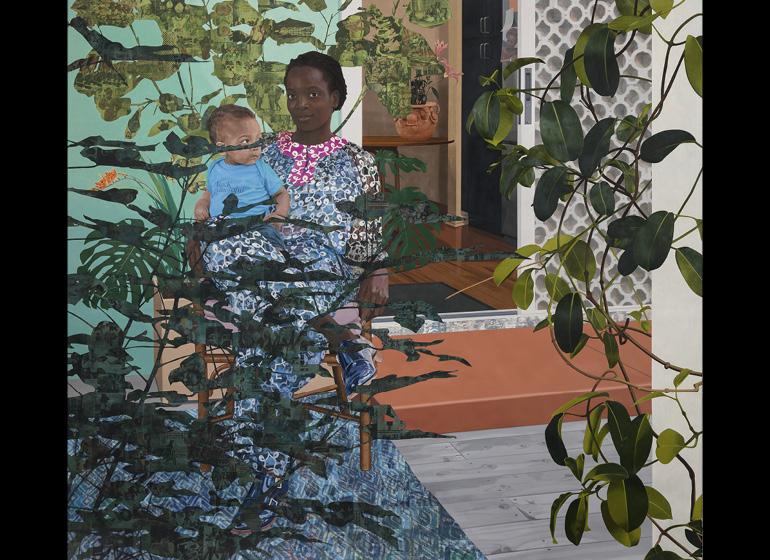“Picturing Motherhood Now” at CMA reimagines our deepest connections
Courtesy of Njideka Akunyili Crosby/clevelandart.org
Experience the warmth of mother’s love in Njideka Akunyili’s “Still You Bloom in this Land of No Gardens”
Walking through the “Picturing Motherhood Now” exhibition at the Cleveland Museum of Art (CMA), one is struck by the sheer power of the bond between mothers and children.
This bond is tucked away inside us, demarcated by love and pain, weakness and growth, rarely visible but constantly present. The relationship between mother and child isn’t invariably easy or challenge free, but the exhibition reminds us that it is steeped in emotional riches that fortify and inspire us. The promise of a mother’s love is not always fulfilled, but it still helps us to find our way in this big world.
The exhibition strives to impress upon visitors that motherhood is both universal and diverse—the works are made by artists who hail from communities of color, indigenous people, immigrants and other identities that have not been historically represented in art. The result is a deeply moving collection of pieces that stress the profound impact mothers’ have on all our lives, whether we ourselves assume the role or we reflect on our relationships with our own mothers.
The first piece in the hall is Mequitta Ahuja’s 2020 oil painting entitled “Portrait of Her Mother,” a gentle rendition of the artist’s studio with Ahuja standing in the foreground, her body turned slightly away as though she is torn between us and her work. Two striking portraits in vibrant reds and blues loom behind her, but their presence is overshadowed by the sketch Ahuja holds up for us to see—the pearly paper shining from the center of the canvas. Etched upon it is a drawing of Ahuja’s mother—the two of them share many striking features, from their sharp cheekbones, to the curve of their noses, to the nearly imperceptible tilt of their heads. It is quite a homage carved out of a single instant, with the smallest moments immortalizing a mother’s impact.
Nearby is “Dinari / All Our Mothers,” an oil by Aaron Gilbert completed in 2019. It’s a difficult moment to observe—a young, pregnant mother and her daughter sit on a sunny bedspread, with the mother’s mouth falling open in concentration as she applies a light eyeshadow to her daughter’s tipped back face. The girl’s hands anchor her to both her mother and the wall, steadying them against the blows of a cruel world—the mother’s legs are horribly bruised with an ankle monitor attached. The tenderness of the scene, the matching lilac nail polish on their feet and the child’s complete trust all contrast painfully with the knowledge that this moment is fleeting, though we are confident that their love is not.
Wendy Red Star’s 2021 photo series, “Amnía (Growth),” is a powerful dedication to the matrilineal family line that has defined her own life and that of her daughter, Beatrice. A photograph of Red Star’s great-great-grandmother, with her hair tied in two braids and a dignified smile on her face, inspired Red Star to recreate the image with herself and Beatrice. Like their ancestor, the two of them are dressed in traditional clothing, their hair braided over their shoulders and their faces beaming with pride and strength. Red Star then amplified the three images ten times each, printed them on boards and stacked them behind one another, producing an overlapping effect between the three generations. Although the women are separated from one another by time and experience, the commonalities between them link their lives indefinitely, reinforcing their positions in their family and the greater world, and providing them with seemingly limitless support and love.
Towards the end of the exhibit are two pieces by mother and son artists Patricia and Jacolby Satterwhite. Patricia, who suffered from schizophrenia throughout the latter part of her life, found great joy in sketching, and in her final years she produced copious drawings inspired by the items she watched on TV shopping channels. Her fantastical inventions are clever and useful, promising levitating beds and magnetic bands that target pinpoints of pain, but evidence of her wandering mind comes through with her jumbled spelling and halting descriptions. Jacolby, a visual artist with a flare for colorful performance works, repurposed some of his mother’s work into his 2020 light piece, “Room for Doubt,” which is a play on Caravaggio’s “The Incredulity of Saint Thomas” (1601-1602). Four figures, accented by the popping glow of neon tubes, lean over each other as though riveted in conversation, words and arrows above their heads reviving the design notes written by Patricia. The pairing of these mediums is bittersweet, forming a haunting tribute to a woman whose creativity sparked inspiration.
As I left the CMA, I wondered how I would pay tribute to my own mom. As an only daughter, I alone make up the bond for my parents, stringing along our little family like clay beads. When my dad’s work took him to the Iraqi desert, my mom and I tried to tie together the fraying pieces, and though I still remained a daughter to her, I also became her sous chef, supporter, easygoing competitor and friend. The relationship has forever changed my life into one with new meaning.
Each work in the collection gives you the opportunity to reflect on the factors and people that make us who we are, diving beyond the concept of maternity into the personal bonds that fortify and empower us all. “Picturing Motherhood Now” will be on display through Mar. 13, 2022 and is free to all Case Western Reserve University students.


